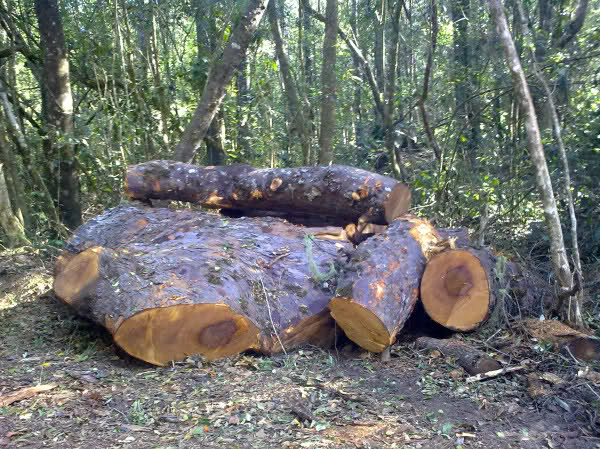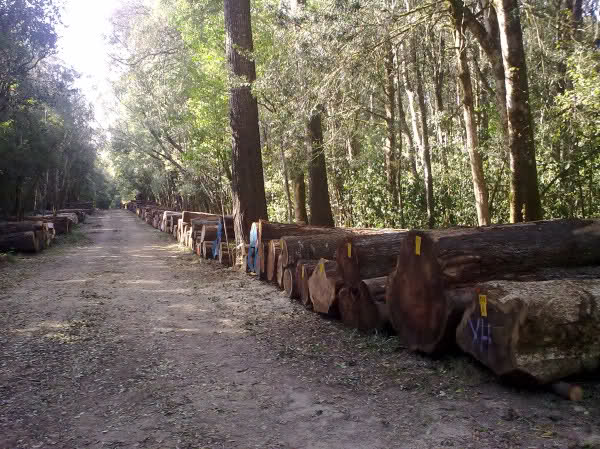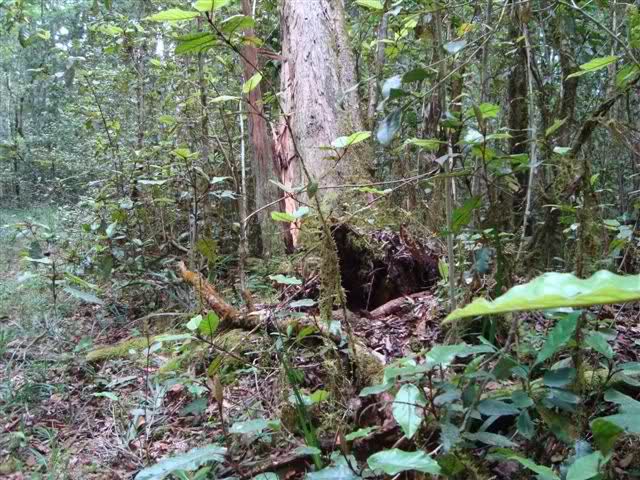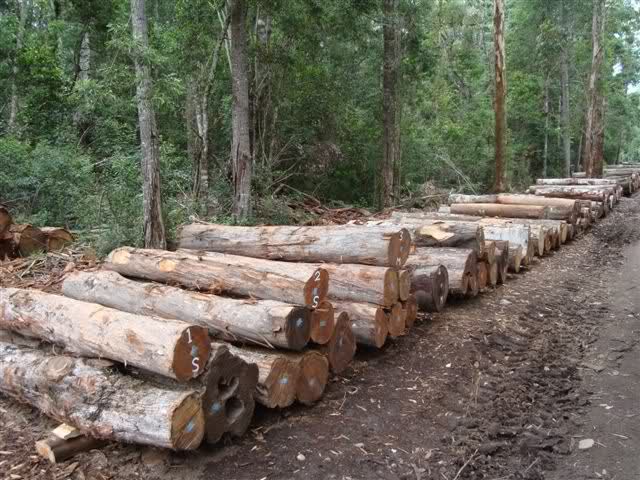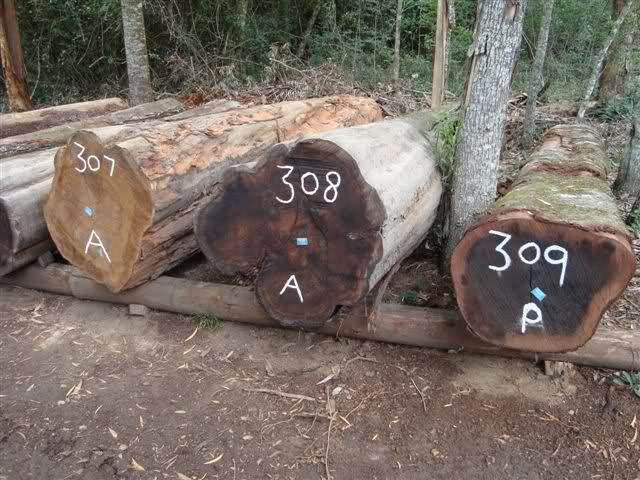iNdlovu wrote:Sanparks have called for tenders to be submitted to begin logging operations In Garden Route National Park.
Logging in the Garden Route National Park
-
iNdlovu
- Posts: 4319
- Joined: Sat May 19, 2012 11:58 am
- Country: South Africa
- Location: Lowveld, South Africa
- Contact:
Logging in the Garden Route National Park
- Lisbeth
- Site Admin
- Posts: 65402
- Joined: Sat May 19, 2012 12:31 pm
- Country: Switzerland
- Location: Lugano
- Contact:
Re: Logging in the Garden Route National Park
Richprins wrote:
In terms of section 7 of the National Forests Act, 1998, no person may
a) cut, disturb, damage or destroy any indigenous tree in a natural forest; or
b) possess, collect, remove, transport, export, purchase, sell, donate or in any other manner acquire or dispose of any tree, or any forest product derived from a tree,
except in terms of—
(i) a licence issued under subsection (4) or section 23; or
(ii) an exemption from the provisions of this subsection published by the Minister in the Gazette on the advice of the Council.
In terms of subsection (4), the Minister may license one or more of the activities referred to in paragraph (a) or (b) of subsection (1).
It can therefore be legal to have timber concessions for indigenous trees in SA’s national parks, but subject to the above conditions and approvals. It is not clear from the advertisement you’ve sent us whether the management authority – SANParks, in this case – has followed or intends to follow the proper procedure and/or has ensured compliance with the above conditions, and it is essential that they do, obviously.
Peter Betts wrote:The Garden Route Park was set up by a previous govt to PROTECT the indigenous forest and what is left of it for future generations. Greed and commercialisation in the park will destroy it.
Richprins wrote:
I GOT this message from Aikona...Friedemann, who has no problem with it being posted here or sent to media!
iNdlovu wrote:
have you sent it to the Lowvelder yet?
Richprins wrote:Yes, but I'm not the only one that can send things on, you know! :lol:
iNdlovu wrote:You've got the contacts there and do such a hell of a good job
- Lisbeth
- Site Admin
- Posts: 65402
- Joined: Sat May 19, 2012 12:31 pm
- Country: Switzerland
- Location: Lugano
- Contact:
Re: Logging in the Garden Route National Park
Richprins wrote:
The Minister's reply to an Aikona member's question:
MINISTER
QUESTION NO. 2202 FOR WRITTEN REPLY: NATIONAL ASSEMBLY
A draft reply to Mr I O Davidson (DA) to the above-mentioned question is enclosed for your consideration.
Ms Nosipho Ngcaba
DIRECTOR-GENERAL
DATE:
DRAFT REPLY APPROVED/AMENDED
MRS B E E MOLEWA, MP
MINISTER OF WATER AND ENVIRONMENTAL AFFAIRS
DATE:
NATIONAL ASSEMBLY
(For written reply)
QUESTION NO. 2202
INTERNAL QUESTION PAPER NO. 25 NW2576E
DATE OF PUBLICATION: 19 August 2011
Mr I O Davidson (DA) to ask the Minister of Water and Environmental Affairs:
(1) Whether, with reference to the public-private partnership opportunity for timber harvesting in the Garden Route National Park as advertised on the SA National Parks (SANParks) website, an environmental impact assessment will be conducted before any harvesting of timber is permitted; if not, why not; if so, what are the relevant details;
(2) how does her department justify that certain types of trees which are regarded as protected trees in terms of the National Forest Act, Act 84 of 1998, are due to be part of the harvested trees;
(3) whether she has found that the (a) harvesting of trees that are responsible for fixing nutrients will have a negative effect on nutrient recycling and (b) removal of canopy trees will dry out forest areas; if not, in each case, how was this conclusion reached; if so, what are the relevant details, in each case;
(4) whether the alien trees that form part of the planned harvesting will be entirely eradicated; if not, why not; if so, what are the relevant details?
Mr I O Davidson (DA)
SECRETARY TO PARLIAMENT
HANSARD
PAPERS OFFICE
PRESS
2202. THE MINISTER OF WATER AND ENVIRONMENTAL AFFAIRS ANSWERS:
1. No. Timber harvesting is a continuation of the timber harvesting programme that has been undertaken on State Forest land for many decades.
Timber has been harvested from the indigenous forests of the Garden Route since the 1770’s. Government attempts to control the harvesting resulted in the development and implementation over decades of policies and practices to curb over-exploitation, culminating in a conservation-orientated, multiple use management approach and a sustainable timber harvest system. Currently the timber of mature trees of several canopy species is harvested mainly for the manufacture of high quality furniture and ornaments by the local furniture industry.
2. Tree species that are protected in terms of the National Forests Act, Act 84 of 1998, that are harvested include stinkwood (Ocotea bullata), common yellowwood (Podocarpus latifolius) and Outeniqua yellowwood (Podocarpus falcatus). All of these species have healthy populations in the Garden Route indigenous forests, with plentiful regeneration. The individual trees are selected for harvesting by applying selection criteria that are based on external, visible signs of senility, declining vigour and low future life expectancy (e.g. severe dieback of the crown, or severe damage to the crown). Trees selected for harvesting are thus either dead or expected to die within the next ten to fifteen years. Trees falling within the selection criteria are marked for removal by trained markers only if they can provide marketable utilizable timber.
Permission to continue harvesting trees of these protected species was delegated to SANParks by the agreement between the then Department of Water Affairs and Forestry and the then Department of Environment Affairs and Tourism to transfer the management of the indigenous State Forests in the Garden Route to SANParks.
3. (a) Harvesting of indigenous timber will take place on only about 3,000 ha on a ten year cycle, thus approximately 300 ha per year, returning to the same area only after ten years. It takes place at a very low intensity, with average harvest rates of two to three trees harvested per hectare (1.5 – 3.5% of all canopy trees) producing two to three cubic metres of indigenous timber per hectare, every ten years. It is usually only the utilizable logs that are removed from the forest, with the non-utilizable parts of the stem, branches and leaves left behind. A very small proportion of the total biomass is thus removed from the forest.
(b) As mentioned above, harvesting takes place at a very low intensity. Disturbance to the forest canopy, which could result in drying out of the forest, is kept to a minimum, and well within naturally occurring limits as determined through research. All of the indigenous trees harvested are either dead or busy dying naturally. In many cases the remaining crown is small due to branches that have died or broken off. Where the crown is still large and likely to cause excessive damage to the surrounding forest, the branches of the tree are cut off carefully before the tree is cut down. The harvesting system thus has minimum ecological impacts and causes minimum deviation from the natural turnover and disturbance mechanisms of the forests.
4. No. Alien tree species that will be harvested will not be entirely eradicated.
The main alien tree species occurring in the Garden Route indigenous forests is Acacia melanoxylon (Blackwood, Australian-, Tasmanian- or Swamp Blackwood), which was introduced to South Africa from Australia in 1848. It was planted extensively in the indigenous forests from about 1909 and is now well established in the natural forests and surrounding open areas.
In the indigenous timber utilization areas blackwood is harvested on a 10-year cycle according to the same schedule for the harvesting of indigenous timber. The largest and other senile trees are selected for harvesting, while healthy trees are left until the following cycle. In other areas once-off harvesting of all utilisable blackwood takes place, focussing on areas where the blackwood is the most senile.
Research on blackwood in the southern Cape and Tsitsikamma indicates that the species does not have the ability to maintain itself at current levels of infestation in the indigenous forest. The species is expected to stabilise at much lower levels due to poor regeneration and natural mortality. It is accepted that these levels of infestation will not have significant negative ecological effects on the forest ecosystem. The high costs of reducing the blackwood infestation to even lower levels are therefore not justified. Even with an active blackwood control program it will not be possible to eradicate all blackwood from the indigenous forest. However, it is predisposed to local dominance along forest margins and riverine areas and can be a serious invader in open and disturbed areas, where active control is carried out.
And the Aikona member's uptake:
What this all boils down to is that SANParks need to get funds from somewhere. As long as SANParks need to generate their own funds, they are going to pursue commercialisation. While it is important that we oppose these activities - hotels, timber harvesting, and mining (mining is specifically included in the hearings for the PA Act, all that needs to happen is the Park be de-proclaimed a Park. This has already happened with the old Vaalbos NP, which was deproclaimed in 2007, supposedly in terms of a land claim, but there was prospecting on the Park while it was a Park including the stopping and diverting of the Vaal river. Mining has also been going on in the Richtersveld NP since its inception), we also need to think towards future commercial fund raising activities and specifically geological carbon sequestration (capturing the emissions of the countries worst polluters then pumping this pollution deep underground and into the sea). SA has just published a White paper on National Climate Change Response, in which they mention a ‘pilot project’ for carbon sequestration – a few years ago the CSIR identified Kruger with its clay soils as a potential site for this. Carbon sequestration will not happen in ‘developed’ areas. It is going to happen in rural/natural areas. What better place than ‘Protected Areas’ who can be paid for the ‘service’?
The way I see it we can either keep on ‘reacting’ and opposing SANParks commercial activities or we can go on the offensive and start coming up with alternatives for funding.
In terms of the ministers reply to the logging:
1) Much has changed since 1770. There have been a lot of trees cut down and new legislation implemented since 1770 due to the cumulative impact of mans activities on the environment over many years. Since 1994 there has been a lot of legislation implemented to specifically protect the environment, because an unprotected environment is harmful to us and we get many benefits from a protected environment such as clean air and water. NEMA is one such piece of legislation.
How can an activity that will have a significant impact be allowed without an EIA?
Isn’t logging a listed activity requiring an EIA, especially logging in a Protected Area (‘listed geographical area’)? I will check up on this (listed activity).
From my point of view, logging will have a ‘significant’ impact on the environment, particularly in a natural forest, which are ‘sensitive’ environments (‘listed environment’?) to begin with located as they are on nutrient poor soils and being not well adapted to fire. The ‘cut lines’ alone will have a significant impact in a natural area. All the arguments against the hotel in Kruger apply equally here. Impact on a ‘protected area’. Public participation. Alternatives. Etc.
2) Protected trees are protected for a reason. What assessments have been done and over what length of time (considering a yellowwood lives for a thousand years), seeing as there has been no EIA done to determine the impact of the logging? From what I’ve seen of the ‘assessments’ and ‘references’ they are all from the pro-timber extraction viewpoint. Its easy to load the dice with ‘references’ that support one particular point of view, without taking into account the other side of the coin or viewpoint, in this case conservation/ecology.
What exactly is a healthy population? How large are the populations of protected trees to be harvested? Are the trees to be harvested located in fragmented pieces of forest or in the large stands of forest? What exactly is ‘plentiful regeneration’, especially considering that the yellowwoods can live up to a thousand years? How many ‘mature’ yellowwoods are there? What is the recruitment of yellowwood trees? How susceptible to mortality are juvenile yellowwood trees (predation, fire, cut lines, competition from aliens like blackwood etc)?
Its one thing to give SANParks authority to manage the ‘ex’ state forests but another thing entirely to give them permission to harvest trees for commercial gain. There is a vast difference between managing a forest for ‘conservation’ and managing a forest for ‘forestry/timber extraction’.
Surely SANParks weren’t given carte blanche authority to harvest trees at will? Are the DEA not the ‘competent authority’ for deciding on this matter?
While the DEA might have delegated powers to SANParks, do the DEA not ultimately remain responsible for the matter?
3) A) Yellowwood trees live for a thousand years. 1770 was a long time ago for us humans, yet in 1770 the trees to be harvested today had already been around for 750 years, with some of them being seedlings in 1066AD during the Battle of Hastings. This is a long time ago. Far beyond what we humans can comprehend.
A ten-year cycle represents only 1% of the total lifespan of a yellowwood tree. Working on a ten-year human cycle for yellowwood trees/hardwood/slow growing trees is not realistic when they take hundreds of years to mature.
Removing 1.5% - 3.5% canopy trees every ten years
means 15%-35% canopy trees every 100 years
150%-350% every 1000years
(1.5% = 700years all gone; 3.5% = 300years all gone – and we’ve been harvesting since 1770)
The definition of ‘sustainable’ is basically not using up a resource quicker than it can replenish itself – how long does it take for a yellowwood tree to replenish itself? Two hundred years? Five hundred?
In terms of the SANParks forest management certification report 2020m³ of timber are to be harvested per year.
To get an idea of volumes being extracted and what 2020m³ per year is, I don’t know the weight of hardwood but do know the weight of water. Hardwood will weigh more than water, but using the weight of a m³ of water will give us a general idea of the ‘biomass’ being extracted every year.
1m³ water weighs 1000kg or 1ton. Therefore 2020m³ = approximately 2 020 tonnes or 2 020 000kg of ‘biomass’ (or 28 857 x 70kg people – something like half the capacity of the 2010 Green Point Soccer Stadium), biomass which includes many nutrients, of which some will be limiting nutrients that have been collected over a thousand years. These are not ‘insignificant’ numbers, certainly not ‘very small’, that are being extracted from nutrient poor soils and ecosystems every year.
The total area of ‘production forest’ or ‘forest from which timber may be harvested’ is 9 276ha of a total of 41 538ha ‘protected’ forest, which represents 22.33% or nearly a quarter of the ‘protected’ forest. What happens when all the utilisable timber has been utilised from this area? Will the other areas then be utilised?
What sort of a fire hazard will the ‘non-utilizable’ parts of the harvested trees pose in adding to the potential fuel load for a fire, particularly in the small patches of forest, while bearing in mind that these forests are not adapted to fire?
What’s the use of proclaiming an area or tree ‘protected’ when it isn’t in fact protected?
B) What are the sizes of the stands of forest that the trees are being harvested from? Harvesting 1.5% - 3.5% of canopy trees will have a very different impact on a stand of forest 10ha, 100ha or 1 000ha in extent, with the impact of drying out smaller stands being far greater than larger stands. Has this been taken into account?
(‘Afromontane Forests in SA are extremely patchy. Of 16 000 ‘patches’ most are smaller than 10ha. Only 30 ‘patches’ are larger than 500ha.’)
4) What impact will the ‘cut lines’, tree felling (exposing roots/soil from the felled tree and flattening undergrowth) and tree removal (dragging heavy tree stumps along the ground) have in disturbing the ground/soil thus creating conditions for the germination and spread of the blackwood?
Is not even trying to eradicate the blackwood tree not at odds with the conservation mandate?
The eradication of the blackwood tree is indicative of the problem with the commercialisation of conservation - decisions regarding conservation are made in terms of Rands and cents and not the true conservation value of an action. The infestation of the Mediterranean mussel in the Garden Route National Park is another prime example of this. Instead of looking for low cost alternative solutions, nothing further will be done because ‘commercialisation’ says there isn’t enough money. The public should be being consulted on these matters to come up with ‘alternatives’ and solutions, as many heads are better than a few.
Its all very well saying ‘the extraction of timber will create jobs’, but what impact will removing the timber have on the water sources in the area which are already under extreme pressure (increased erosion, evaporation, siltation etc)? There’s little point having a job, if there’s no water to drink, cook and wash with.
Is anything being done to replace the harvested trees? What about planting seedlings along the roadsides etc as done in Germany? (“in parts of Germany they practice urban forestry. Many German towns carry on an active city forestry along roads/road reserve. From 60-80% of total city income is thus derived from city forest products”).
Richprins wrote:I don't think the minister herself has any clue whatsoever as to the contents of "her" reply, and would love to find out who actually wrote it!
It also seems that they have not seen the pics of the felled trees, and are sticking to the 20th century mantra of "diseased" trees only being felled, which is absolute hogwash!!!!!
Pathetic!
iNdlovu wrote:I am astounded that an EIA was not carried out....they are breaking the law in my opinion
Richprins wrote:Link fixed!:twisted:
Poplap wrote:
Thank you to the Aikona member for pointing out the fallacies in the reply above.
Excerpt from the AM's post:
The way I see it we can either keep on ‘reacting’ and opposing SANParks commercial activities or we can go on the offensive and start coming up with alternatives for funding.
I agree. I dislike being reactive iso proactive. However, since when does the nation need to fund conservation for future generations? Who will be controlling these donations, and which pockets will it line / which extravagant hotel bills will it pay for?
http://www.iol.co.za/capeargus/da-guns- ... -1.1170707
Richprins wrote:The member sent out a lot of technical pics taken personally on Dec 8, which I don't really understand...members are welcome to PM me for the file.
Some examples:
(A tree that REALLY died of natural causes:)
More logs ready:
Penga Ndlovu wrote:Hey guys.
Maybe I am just a bit off base here, but could it be not so that the forest really needed to be thinned out so the other trees have more space to grow?
If so I do not have a problem with SanParks making money out of it to put back into conservation.
But if they are only doing it to gather money my vote is firmly against all of this.
Maybe Forestgump can shed a light on this.
Penga Ndlovu wrote:I know, from experience that what my father taught me, he is in that kind of business, that it is not always possible to replant trees that have been taken out of the ground.
Sometimes also great big majestic trees need to be removed in order to give others, that have a better chance of survival, a chance to survive.
I hear what all of you are saying and I hope, like I said initially, that I am wrong about this, but sometimes one has to weed in order for other species to grow.
RP.
Yes. You are correct, but I am only asking myself these questions.
Like you have said many times in other threads.
Let's keep our options open.
You know me.
Usually I am like a Wildebees in a Porcelain store, but sometimes I can ask myself the occasional question or two.
Geez.
I sound almost human.
-O -O -O -O -O -O
Poplap wrote:Thanks for the images, RP.
If I am not mistaken, Friedemann circulated an e-mail, stating that SANParks was not making money through this process, but actually losing money. Do you still have that e-mail? Please?
iNdlovu wrote:If I recall it went something along the lines of 'SanParks is setting up the loggers for failure'. Apparently with the difficulty in retrieveing the timber from the hard to reach places, it is going to cost more than what they tendered for or something like that.
Re: Logging in the Garden Route National Park
Who actually wrote it? The minister's replay to no 1 and no 2 is quoted from the SANParks Draft Management Plan for the GARDEN ROUTE NATIONAL PARK, March 2010 (p. 116 pdf document here)Richprins wrote:I don't think the minister herself has any clue whatsoever as to the contents of "her" reply, and would love to find out who actually wrote it!
It also seems that they have not seen the pics of the felled trees, and are sticking to the 20th century mantra of "diseased" trees only being felled, which is absolute hogwash!!!!!
Pathetic!
Similar in the Management Plan for the GARDEN ROUTE NATIONAL PARK, January 2012 (p. 74 pdf document here)
What the minister said to no. 2 is found in an article of the SA Forestry magazine or the sources of this article (Timber yield regulation in the indigenous forests of the Garden Route)
Extractive resource use from terrestrial ecosystems is an important component of the management of the Garden Route National Park. This is both from the historical perspective as well as to comply with policy directives to accommodate the need for access to resources, to optimise socio-economic benefits to neighbouring communities, and to generate income for the organisation.
- H. erectus
- Posts: 5841
- Joined: Fri Jun 01, 2012 6:43 pm
- Country: South Africa
- Contact:
Re: Logging in the Garden Route National Park
.Gov you have failed all else!!
Please do not attempt reaping here!!!
Please do not attempt reaping here!!!
Heh,.. H.e
- H. erectus
- Posts: 5841
- Joined: Fri Jun 01, 2012 6:43 pm
- Country: South Africa
- Contact:
Re: Logging in the Garden Route National Park
.Gov if you are so successful, why pilver
with natural heritage????
with natural heritage????
Heh,.. H.e
- Lisbeth
- Site Admin
- Posts: 65402
- Joined: Sat May 19, 2012 12:31 pm
- Country: Switzerland
- Location: Lugano
- Contact:
Re: Logging in the Garden Route National Park
H.e., do you know if they are still logging?
"Education is the most powerful weapon which you can use to change the world." Nelson Mandela
The desire for equality must never exceed the demands of knowledge
The desire for equality must never exceed the demands of knowledge
- H. erectus
- Posts: 5841
- Joined: Fri Jun 01, 2012 6:43 pm
- Country: South Africa
- Contact:
Re: Logging in the Garden Route National Park
No I don't Lisbeth, but heck do I have much choise
other than the sour one I possess????
other than the sour one I possess????
Heh,.. H.e
- Lisbeth
- Site Admin
- Posts: 65402
- Joined: Sat May 19, 2012 12:31 pm
- Country: Switzerland
- Location: Lugano
- Contact:
Re: Logging in the Garden Route National Park
Unfortunately our ways of protesting are limited, but until we have words, we can still voice our discontent 

"Education is the most powerful weapon which you can use to change the world." Nelson Mandela
The desire for equality must never exceed the demands of knowledge
The desire for equality must never exceed the demands of knowledge
- H. erectus
- Posts: 5841
- Joined: Fri Jun 01, 2012 6:43 pm
- Country: South Africa
- Contact:
Re: Logging in the Garden Route National Park
Lisbeth, most unforetunately so many folks have become
so disgruntled at what is happening here in this country!
We have become a super tense disillusioned bunch looking
for mistakes. And in all fairness sometimes over the top!!
If by example I take Vannesa and her labour
of love heck it she deserves more than just 48hrs per each
day in fact she needs her mental faculties sectioned into at
least more than one frame of mind, Not easy at the best of
times!!!
Maybe this logging thing is spam but just in case!!!! Lay off,
those trees are heritage so .gov better you have a good reason
for felling!!!
so disgruntled at what is happening here in this country!
We have become a super tense disillusioned bunch looking
for mistakes. And in all fairness sometimes over the top!!
If by example I take Vannesa and her labour
of love heck it she deserves more than just 48hrs per each
day in fact she needs her mental faculties sectioned into at
least more than one frame of mind, Not easy at the best of
times!!!
Maybe this logging thing is spam but just in case!!!! Lay off,
those trees are heritage so .gov better you have a good reason
for felling!!!
Heh,.. H.e



